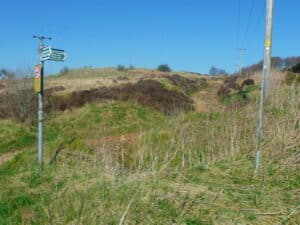Support us from £3/month
We deal with almost 1000 cases a year assisting communities, groups and individuals in protecting their local spaces and paths in all parts of England and Wales. Can you help us by joining as a member?
We have welcomed the decision of an inspector to refuse an exchange of common land in Brontë country at Brow Moor, Haworth, Bradford.

This footpath leads to the release land which lies at the top of the rise. © Copyright Humphrey Bolton and licensed for reuse under the Creative Commons Licence
Dennis Gillson and Son Ltd (Gillsons) applied to deregister 1.25 hectares of common land on Brow Moor, and replace it with 2.7 hectares about 2 kilometres further south. The application was made to the Planning Inspectorate to enable an extension of Naylor Hill Quarry, further onto the common, for extraction of the distinctive sandstone-block building stone. The extension had received planning permission from Bradford Metropolitan District Council, but also required the Secretary of State’s consent to dispense with the status of the land as common land. The Mineral Planning Group Ltd acted for Gillsons.
Gillsons proposed to offer replacement land, to be registered as common land, at the southern end of Black Moor Road, above Leeming; this comprised two walled fields (here).
The society objected to the application, saying that the replacement land was too distant from Brow Moor and Keighley, inaccessible from Oxenhope (along Denholme Road largely lacking a pavement), characterless, enclosed, and indistinguishable from neighbouring fields. It also noted that commoners on Brow Moor attempting to turn out sheep on the replacement land would be competing with the tenant farmer, and had no guarantee of well-maintained boundaries nor a water supply.
In his decision letter, inspector W Johnson opined against the remoteness of the replacement land from Brow Moor, saying that this ‘would negatively outweigh any…benefits’ from the increase in grazing area. The proposed exchange would disadvantage the local neighbourhood, while the release land at Brow Moor had ‘positive ecological value’ which ‘makes a significant contribution to the verdant and rural appearance of the Common as a whole’. The ‘features of the [replacement] land…would deter a proportion of the public from walking on it’, and public access would diminish. He found that the exchange was against the public interest. Consent was refused.
Our case officer Hugh Craddock said: ‘This is a sensible and welcome decision by the inspector. The proposed exchange was poorly researched, inadequate and inappropriate. It would have replaced the joy of the heather and gorse on the heights of Brow Moor, with characterless enclosed fields. The public would hardly know the replacement common land was there and available for recreation.’
Hugh continued: ‘We do not inevitably object to a quarry extension. But if the applicants want to destroy part of the common, they will have to come up with something good in its place. And this proposal wasn’t fit for purpose.’
